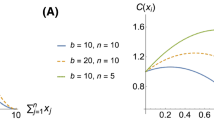Summary:
Social insect colonies can respond to changes in resource availability by altering their foraging behavior. Colonies of the desert ant, Aphaenogaster cockerelli, responded to experimental changes in the distribution and type of available resources by adjusting the numbers of ants engaged in foraging and other tasks outside the nest, and by adjusting the temporal patterns of these activities. Colonies foraged more intensely for protein resources than for seed resources, and for high-density resources more than for low-density resources. This flexible allocation and resource use may promote coexistence with interspecific competitors such as ants in the genus Myrmecocystus.
Similar content being viewed by others
Author information
Authors and Affiliations
Additional information
Received 4 April 2002; revised 8 July 2002; accepted 12 July 2002.
RID="*"
ID="*"Current address: Department of Biological Sciences, Humboldt State University, Arcata, CA 95521, USA, e-mail: njs12@humboldt.edu
Rights and permissions
About this article
Cite this article
Sanders, N., Gordon, D. Resources and the flexible allocation of work in the desert ant, Aphaenogaster cockerelli . Insectes soc. 49, 371–379 (2002). https://doi.org/10.1007/PL00012661
Issue Date:
DOI: https://doi.org/10.1007/PL00012661




